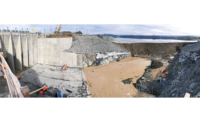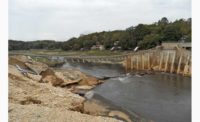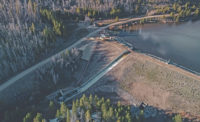Folsom Dam Auxiliary Spillway Phase IV
Folsom, Calif.
Best Project, Water/Environment
Key Players
Owner: U.S. Army Corps of Engineers
General Contractor: Kiewit Infrastructure West Co.
Subcontractors: Malcolm Drilling Co., CMC Rebar, Neils Controlled Blasting LP, Suulutaaq Inc. and Blocka Construction
Built as part of an effort to prevent overtopping of Folsom Dam and to protect Sacramento against 200-year floods, the Folsom Dam Auxiliary Spillway project team overcame numerous technical and logistical challenges to deliver the $318-million project.
Led by a joint effort between the U.S. Army Corps of Engineers and the Dept. of the Interior, Kiewit Infrastructure West delivered an 1,100-ft-long approach channel, a 2,000-ft-long upper spillway channel, a 900-ft-long step chute and a 200-ft-long stilling basin in 41 months—four months ahead of schedule. More than 1 million man-hours were logged in the process.
Faced with a mandated completion date of May 1, 2017, the Corps of Engineers Sacramento District staff knew the project would require unprecedented levels of teamwork, says Kristine Des Champs, senior project manager in the Sacramento District.
“This is our first project I’ve seen that used such a high level of partnering,” she says. “We’re now taking [those practices] to other projects. Each Corps project is unique in its own way, but this one transcended what we typically do.”
The auxiliary spillway project is the fourth phase in the $900-million Folsom Dam Auxiliary Spillway Program. While Phase III was underway, the Corps determined that it would need to overlap Phases III and IV to meet its deadline. Phase III was being delivered by a different contractor—Granite Construction. The two teams each had more than 200 personnel on site at times and needed to share the same access, laydown and work zones.
The two teams and the Corps met every week to address logistical concerns. “The intent was to make sure we looked at the issues we had that week and in the following weeks,” says Luis Paiz, project manager with Kiewit. “More importantly, we wanted to recognize the biggest challenges that we had for the duration of the project and make sure we had a plan in place.”
As part of the coordination process, the two teams developed a secondary access road to the site, constructing a trestle bridge that diverted Phase IV construction traffic away from the Phase III work zone.
A series of one- to three-acre benches for additional laydown areas were also built adjacent to the Phase III work zone. This was enabled by installing temporary mechanically stabilized earth walls on an otherwise unusable slope. Kiewit also relocated a concrete batch plant to facilitate site access for both contractors, creating an atypical, vertically oriented batch plant configuration.
“The level of communication and coordination we had and the ability to trust each other and resolve issues made it possible for us to exist in such a small space,” Paiz adds.
Early on, the Kiewit team also faced significant challenges within its own scope of work. During the excavation of the approach channel, the team discovered that underlying rock couldn’t support the channel’s structures as originally designed. Complete redesign of related structures was required, which threatened the schedule. Paiz says crews needed to work in the channel while Folsom Lake was in its low-water season.
“Water levels can fluctuate more than 100 ft in a season,” he says. “We needed to be done during the low-water season so we could finish in the dry. Otherwise, the water would rise again and we’d have to wait a full season for it.”
While the redesign was underway, Kiewit continued to work on critical items by re-sequencing work and developing strategic crane access.
“It was absolutely critical for Keiwit to communicate issues and provide technical solutions to the Corps so we could decide on the best solution for a particular issue, agree on it and then move forward,” Paiz says. “There was no time to negotiate the change. We moved at the speed of trust.”
The approach channel also required underwater excavation and cleaning. The team used air-lift dredging to remove fine material as well as GPS mapping and a sunken PVC pipe grid system to help divers confirm locations of inspection and confirm if the finished grade conformed to specifications. Aerial drones scanned and mapped cleaned rock surfaces prior to the placement of dental concrete.
With the project coming to completion in December 2016, the Corps met its deadline with four months to spare, meeting its flood-risk management mission. “With all the rain in Northern California this year, it’s good to see the investment in this infrastructure,” a Best Projects judge said.
Related Article: Communities Are the Real Winners








Post a comment to this article
Report Abusive Comment